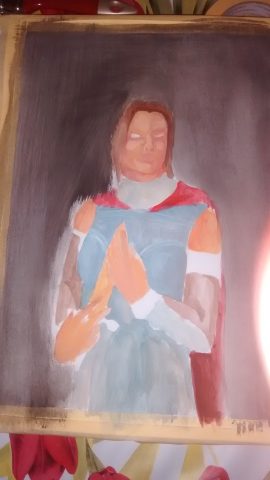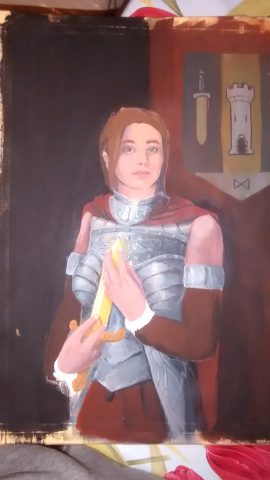AKA: what I did wrong in my first portrait ever.
I’ve done other portraits, but they were small works copied from a photo reference (actors, friends…); this time, I challenged myself to use no reference at all. Here the result:

Yeah, I know, not the greatest result ever. I know what I got wrong here and I want to explain why I am still proud of what I accomplished.
The sketch
The pencil drawing wasn’t good from the beginning. I didn’t double-check the anatomy, details weren’t estabilished and I didn’t set a light source. All of this spelled disaster, but I was too confident I would fix things while painting. Guess I had to make that mistake to learn.
References
If I could go back and change a single thing of this work, it would be this. I desperately needed real life references, but I didn’t know yet.
The underpainting
Non-existent. Really, what was going through my mind? I just picked up colors and put them on the sheet, totally skipping the “estabilish a general mood” step. Worst idea EVER.
The “rip-it-and-do-it-over”
Fair early during the painting, I decided I wasn’t going anywhere. The colors were wrong and didn’t matter what I did, I couldn’t fix them. So I just put that aside and started from scratch. Did I learn something? Apparently not, since I remade those mistakes over and over.

The actual painting
The whole process took me something like 30 hours, spread over three months. Another bad idea, since too much time passed between sessions, and I would get used to the appearance of the unfinished work.
I first detailed the face. I was thinking, “hey, the face is the most difficult thing to do, so let’s just focus on it and forget about everything else for now”. So, ten of those thirty hours went into the face while the rest of the painting was blank or had just a slight undertone.
Then, oh gawd the anatomy. Halfway in there, I realized the neck and shoulders were totally off. Another 5 hours went into trying to correct the shoulders. For the right hand, it was already too late.

The armor
I tried to avoid the armor til last moment. I have this thing with painting metal: I always say, “nah bro, too difficult, I’m gonna cry blood over this”, and then halfway in I’m like “oh yeah, I forgot that I’m actually good in rendering metal”. The fact is, I paint metal far better than, say, skin or fabric: having always used ink, I’m used to strong separation between light and shadow, and that’s actually what makes metal… metal. When I paint, I tend to put flat shadows and lighting over a flat surface: on almost everything else I have to sweat over a smooth transition, but with metal I can quite skip the smoothing. Hooray for metal.

Final touches
Since my effort on various bits of the work was so uneven, the painting took that ugly inconsistent look. Some parts, like the face and the armlet, are smooth and refined, while others seem just unfinished or sketchy.
What I learned
I don’t like painting with acrylics. They make beautifully vibrant colors, but they’re just not my medium. Very powerful, though, and will totally use them again.
Use references. There’s no shame in them, and are literally unavoidable. Everything can improve with references: drapery, anatomy, shading, texturing… everything.
A good pencil drawing puts you halfway through a good painting.
Estabilish lights and shadows BEFORE starting.
Work throughout the entire painting, and not a detail at a time.
I’m good with metal. Don’t fear that again. Fear fabric, if you must (I hate drapery).
Keep on painting. You learned a lot of stuff from this. You can do better.